Constantinople › Constantius II › Aristotle's On the Heavens » Origins and History
Articles and Definitions › Contents
- Constantinople › Origins
- Constantius II › Who Was
- Aristotle's On the Heavens › Origins
Ancient civilizations › Historical places, and their characters
Constantinople › Origins
Definition and Origins
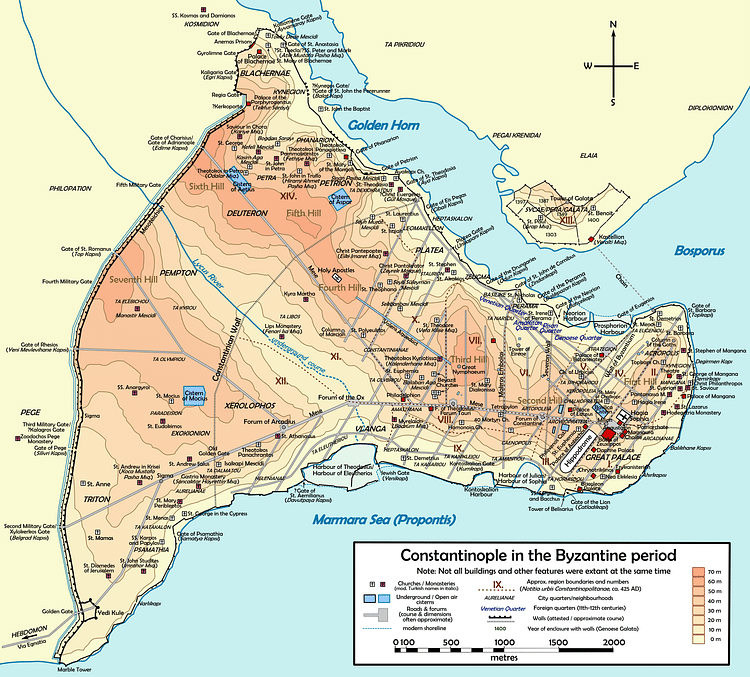
Built in the seventh century BCE, the ancient city of Byzantium proved to be a valuable city for both the Greeks and Romans.Because it lay on the European side of the Strait of Bosporus, the Emperor Constantine understood its strategic importance and upon reuniting the empire in 324 CE built his new capital there -- Constantinople.
FOUNDATION BY CONSTANTINE (284 - 337 CE)
Emperor Diocletian who ruled the Roman Empire from 284 to 305 CE believed that the empire was too big for one person to rule and divided it into a tetrarchy (rule of four) with an emperor ( augustus ) and a co-emperor ( caesar ) in both the east and west. Diocletian chose to rule the east. Young Constantine rose to power in the west when his father, Constantius, died. The ambitious ruler defeated his rival, Maxentius, for power at the Battle of Milvian Bridge and became sole emperor of the west in 312 CE. When Lucinius assumed power in the east in 313 CE, Constantine challenged and ultimately defeated him at the Battle of Chrysopolis, thereby reuniting the empire.
Constantine was unsure where to locate his new capital. Old Rome was never considered. He understood the infrastructure of the city was declining; its economy was stagnant and the only source of income was becoming scarce. Nicomedia had everything he could want for a capital --a palace, a basilica and even a circus-- but it had been the capital of his predecessors, and he wanted something new. Although he had been tempted to build his capital on the site of ancient Troy, Constantine decided it was best to locate his new city at the site of old Byzantium, claiming it to be a New Rome (Nova Roma ). The city had several advantages. It was closer to the geographic center of the Empire. Since it was surrounded almost entirely by water, it could be easily defended (especially when a chain was placed across the bay). The location provided an excellent harbor --thanks to the Golden Horn-- as well as easy access to the Danube River region and the Euphrates frontier. Thanks to the funding of Lucinius's treasury and a special tax, a massive rebuilding project began.
CONSTANTINOPLE WOULD BECOME THE ECONOMIC AND CULTURAL HUB OF THE EAST AND THE CENTER OF BOTH GREEK CLASSICS AND CHRISTIAN IDEALS.
Although he kept some remnants of the old city, New Rome --four times the size of Byzantium-- was said to have been inspired by the Christian God, yet remained classical in every sense. Built on seven hills (just like Old Rome), the city was divided into fourteen districts. Supposedly laid out by Constantine himself, there were wide avenues lined with statues of Alexander the Great, Caesar, Augustus, Diocletian, and of course, Constantine dressed in the garb of Apollo with a scepter in one hand and a globe in the other. The city was centered on two colonnaded streets (dating back to Septimus Severus) that intersected near the baths of Zeuxippus and the Testratoon.
The intersection of the two streets was marked by a four-way arch, the tetraphylon. North of the arch stood the old basilica which Constantine converted into a square court, surrounded by several porticos, housing a library and two shrines.Southward stood the new imperial palace with its massive entrance, the Chalke Gate. Besides a new forum, the city boasted a large meeting hall that served as a market, stock exchange, and court of law. The old circus was transformed into a victory monument, including one monument that had been erected at Delphi --the Serpent Column -- celebrating the Greek victory over the Persians at Plataea in 479 BCE. While the old amphitheater was abandoned (the Christians disliked gladiatorial contests), the hippodrome was enlarged for chariot races.
One of Constantine's early concerns was to provide enough water for the citizenry. While Old Rome didn't have the problem, New Rome faced periods of intense drought in the summer and early autumn and torrential rain in the winter. Together with the challenge of the weather, there was always the possibility of invasion. The city needed a reliable water supply. There were sufficient aqueducts, tunnels and conduits to bring water into the city but a lack of storage still existed. To solve the problem the Binbirderek Cistern (it still exists) was constructed in 330 CE.
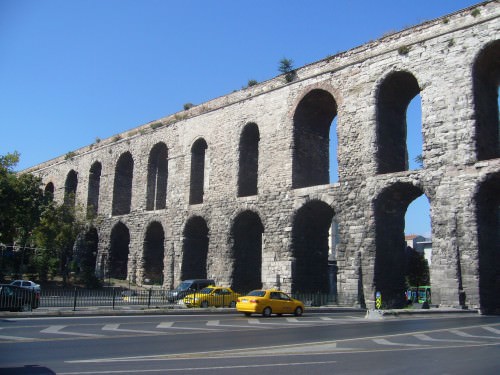
Valens Aqueduct, Constantinople
Religion took on new meaning in the empire. Although Constantine openly supported Christianity (his mother was one), historians doubt whether or not he truly ever became a Christian, waiting until his deathbed to convert. New Rome would boast temples to pagan deities (he had kept the old acropolis ) and several Christian churches; Hagia Irene was one of the first churches commissioned by Constantine. It would perish during the Nika Revolts under Justinian in 532 CE.
In 330 CE, Constantine consecrated the Empire's new capital, a city which would one day bear the emperor's name.Constantinople would become the economic and cultural hub of the east and the center of both Greek classics and Christian ideals. Its importance would take on new meaning with Alaric ’s invasion of Rome in 410 CE and the eventual fall of the city to Odoacer in 476 CE. During the Middle Ages, the city would become a refuge for ancient Greek and Roman texts.
CONSTANTIUS TO THEODOSIUS (337 - 526 CE)
In 337 CE Constantine died, leaving his successors and the empire in turmoil. Constantius II defeated his brothers (and any other challengers) and became the empire's sole emperor. The only individual he spared was his cousin Julian, only five years old at the time and not considered a viable threat; however, the young man would surprise his older cousin and one day becomes an emperor himself, Julian the Apostate. Constantius II enlarged the governmental bureaucracy, adding quaestors, praetors, and even tribunes. He built another cistern and additional grain silos. Although some historians disagree (claiming Constantine laid the foundation), he is credited with building the first of three Hagia Sophias, the Church of Holy Wisdom, in 360 CE. The church would be destroyed by fire in 404 CE, rebuilt by Theodosius II, destroyed and rebuilt again under Justinian in 532 CE.
A convert to Arianism, Constantius II's death would place the already tenuous status of Christianity in the empire in jeopardy.His successor, Julian the Apostate, a student of Greek and Roman philosophy and culture (and the first emperor born in Constantinople), would become the last pagan emperor. Although Constantinius had considered him weak and non-threatening, Julian had become a brilliant commander, gaining the support and respect of the army, easily assuming power upon the emperor's death. Although he attempted to erase all aspects of Christianity in the empire, he failed. Upon his death fighting the Persians in 363 CE, the empire was split between two brothers, Valentinian I (who died in 375 CE) and Valens.Valentinian, the more capable of the two, ruled the west while the weaker and short-sighted Valens ruled the east. Valens only contribution to the city and the empire was to add a number of aqueducts, but in his attempt to shore up the empire's frontier --he had allowed the Visigoths to settle there-- he would lose a decisive battle and his life at Adrianople in 378 CE. After Valens embarrassing defeat, the Visigoths believed Constantinople to be vulnerable and attempted to scale the walls of the city but ultimately failed.
Valen's successor was Theodosius the Great (379 – 395 CE). In response to Julian, he outlawed paganism and made Christianity the official religion of the empire in 391 CE. He called the Second Ecumenical Council, reaffirming the Nicene Creed, written under the reign of Constantine. As the last emperor to rule both east and west, he did away with the Vestal Virgins of Rome, outlawed the Olympic Games and dismissed the Oracle at Delphi which had existed long before the time of Alexander the Great. His grandson, Theodosius II (408 – 450 CE) rebuilt Hagia Sophia after it burned, established a university, and, fearing a barbarian threat, expanded the city's walls in 413 CE; the new walls would be forty feet high and sixteen feet thick.
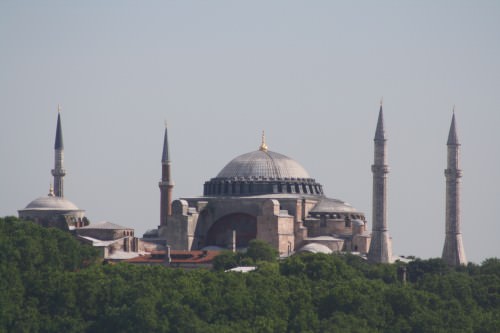
Hagia Sophia
JUSTINIAN & THE NIKA REVOLT (527 - 565 CE)
A number of weak emperors followed Theodosius II until Justinian (527 – 565 CE) --the creator of the Justinian Code-- came to power. By this time the city boasted over three hundred thousand residents. As emperor Justinian instituted a number of administrative reforms, tightening control of both the provinces and tax collection. He built a new cistern, a new palace, and a new Hagia Sophia and Hagia Irene, both destroyed during the Nika Revolt of 532 CE. His most gifted advisor and intellectual equal was his wife Theodora, the daughter of a bear trainer at the Hippodrome. She is credited with influencing many imperial reforms: expansion of women's rights in divorce, closure of all brothels, and the creation of convents for former prostitutes.Under the leadership of his brilliant general Belisarius, Justinian expanded the empire to include North Africa, Spain and Italy. Sadly, he would be the last of the truly great emperors; the empire would fall into gradual decline after his death until the Ottoman Turks conquered the city in 1453 CE.
One of the darker moments during his reign was the Nika Revolt. It started as a riot at the hippodrome between two sport factions, the blues and greens. Both were angry at Justinian for some of his recent policy decisions and openly opposed his appearance at the games. The riot expanded to the streets where looting and fires broke out. The main gate of the imperial palace, the Senate house, public baths, and many residential houses and palaces were all destroyed. Although initially choosing to flee the city, Justinian was convinced by his wife, to stay and fight: thirty thousand would die as a result. When the smoke cleared, the emperor saw an opportunity to clear away remnants of the past and make the city a center of civilization.Forty days later Justinian began the construction of a new church; a new Hagia Sophia.
No expense was to be spared. He wanted the new church to be built on a grand scale -- a church no one would dare destroy.He brought in gold from Egypt, porphyry from Ephesus, white marble from Greece and precious stones from Syria and North Africa. The historian Procopius said:
… it soars to a height to match the sky, and as if surging up from other buildings it stands as high and looks down on the remnants of the city … it exults in an indescribable beauty.
Over ten thousand workers would take almost six years to build it. Afterwards Justinian was reported to say, “ Solomon, I have surpassed thee.” Near the height of his reign, Justinian's city suffered an epidemic in 541 CE --the Black Death-- where over one hundred thousand of the city's residents would die. Even Justinian wasn't immune, although he survived. The economy of the empire would never completely recover.
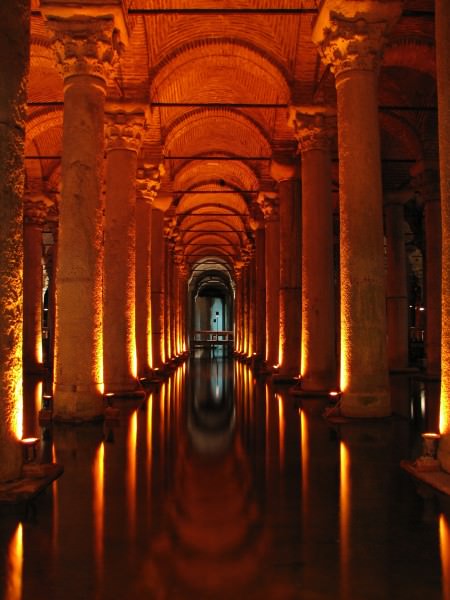
Binbirderek Cistern, Constantinople
MEDIEVAL CONSTANTINOPLE (UNTIL 1453 CE)
Two other emperors deserve mention: Leo III and Basil I. Leo III (717 – 741 CE) is best known for instituting iconoclasm, the destruction of all religious relics and icons --the city would lose monuments, mosaics and works of art-- but he should also be remembered for saving the city. When the Arabs lay siege to the city, he used a new weapon “ Greek fire ”, a flammable liquid to repel the invaders. It was comparable to napalm, and water was useless against it as it would only help to spread the flames. While his son Constantine V was equally successful, his grandson Leo IV, initially a moderate iconoclast, died shortly after assuming power, leaving the incompetent Constantine VI and his mother and regent Irene in power. Irene ruled with an iron hand, preferring treaties to warfare, aided by several purges of the military. Although she saw the return of religious icons (endearing her to the Roman church), her power over her son and the empire ended when she chose to have him blinded; she was exiled to the island of Lesbos.
Basil I (867- 886 CE), the Macedonian (although he had never set foot in Macedonia), saw a city and empire that has fallen into disrepair and set about a massive rebuilding program: Stone replaced wood, mosaics were restored, churches as well as a new imperial palace were constructed, and lastly, considerable lost territory was recovered. Much of the rebuilding, however, was lost during the Fourth Crusade (1202 -1204 CE) when the city was plundered and burned, not by the Muslims, but by the Christians who had initially been called to repel invaders but sacked the city themselves. Crusaders roamed the city, tombs were vandalized, churches desecrated, and Justinian's sarcophagus was opened and his body flung aside. The city and the empire never recovered from the Crusades leaving them vulnerable for the Ottoman Turks in 1453 CE.
Constantius II › Who Was
Definition and Origins
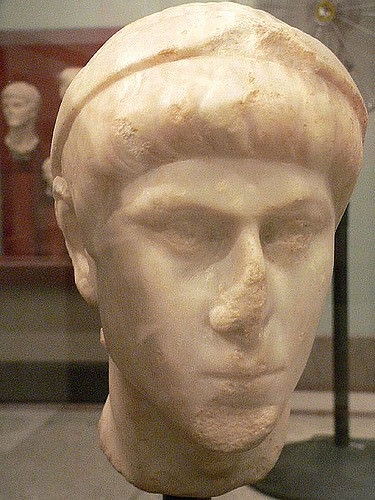
Constantius II ruled the Roman Empire between 337-361 CE. He was the second son of Constantine the Great and Fausta. Constantius was a devout follower of Arianism Christianity. Ruling for 24 years, he was the longest reigning son of Constantine and therefore, arguably, the most successful.
EARLY LIFE
Ammianus Marcellinus records his life and reign in great detail. However, the hostility of the historian has forever marred the reputation of this successful emperor, recording that his reign was plagued by imperial insecurity, court intrigue and an inability to solve widespread religious controversies.
Constantius was responsible for the slaughter of his cousins and uncles, of Theodora's line during the great massacre of 337 CE. Such a slaughter within the imperial family itself was unprecedented. Murdering his relatives (such as Dalmatius, Hannibalianus and Julius Constantius), whom he saw as challengers to his and his brothers' ascensions to the throne, Constantius secured his own position within the Empire. The only two male members of this line of the imperial family to survive were Gallus and Julian. Thus, after this slaughter and the division of the empire between Constantine's sons, Constantius was able to secure the most prestigious and wealthiest provinces in the east for himself, and perhaps more importantly; Constantinople – the new capital of the Roman Empire. Eventually, after the death of his brothers; Constantine II and Constans, he became sole ruler of the Roman Empire. However, learning the lessons from Diocletian and Constantine the Great he realised that to rule and secure the empire on his own was impossible, thus throughout his reign he subsequently promoted his only surviving male relatives, Gallus and later Julian as his Caesars.
CONSTANTIUS WAS ESPECIALLY SKILLED AT CEMENTING THE INTERNAL STABILITY OF THE EMPIRE.
DEFENDING THE EMPIRE
The main criticism levelled at Constantius was his cautious and defensive foreign policy. This is understandable given that most Roman contemporaries, even in the Later Roman Empire, were still obsessed with the idea of conquest and expansion.Yet this defensive policy safeguarded the frontiers of the empire against the Sassanian Empire – which was resurgent during the reign of the ambitious and skilful Shapur II – and the increased threat of the Germanic tribes in the west. His policy was also extremely important in protecting and conserving Rome ’s limited manpower strength. The vicious cycle of usurpation, civil war and dynastic murder had led to wider imperial insecurity and vulnerability, making aggressive foreign campaigns ever more dangerous and unwise. The civil wars that had wrecked the empire were particularly damaging and always proved a huge drain on Roman manpower. For example, during Constantine's conflict with Magnentius, his brothers' murderer, Constantius lost 40% of his men while his rival's army suffered a loss of 2/3.
Therefore, although Constantius' foreign policy of defence and containment received a lot of criticism it proved a lot more effective than an aggressive policy would have done and indeed it actually formed the precedent for the later overall strategy of the Roman Empire.
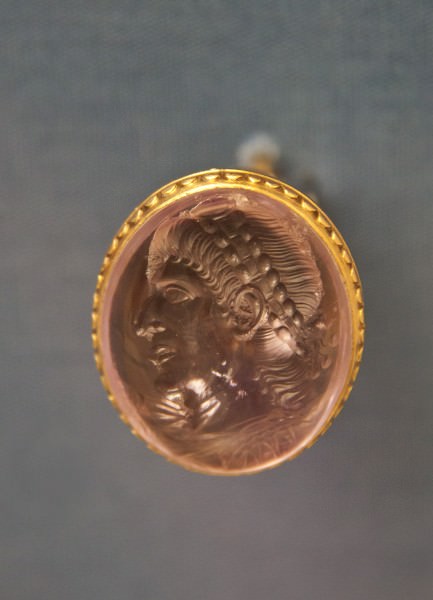
Constantius II
Constantius was especially skilled at cementing the internal stability of the Empire – a fact that is often overlooked considering the bloody civil wars and unrest that had previously threatened the empire. During his reign he faced many varied internal threats and challengers. These included;
1) Vertranio: who had briefly been proclaimed by the Danube legions, was quickly disposed of
2) Magnentius: survived three years of war with his brothers' killer. Finally defeated him at the battle of Mons Seleuci. (later proscribed the followers of Magnentius [Amm. Marc. 14.5.2-5])
3) Silvanus: the Frankish-born general was disposed of through a trick [Amm.Marc. 15.5.3-31]
4) Caesar Gallus: who was suspected of insubordination and was quickly checked and done away with.
5) Caesar Julian: openly rebelled against Constantius and succeeded – mainly because Constantius died before he could give battle.
2) Magnentius: survived three years of war with his brothers' killer. Finally defeated him at the battle of Mons Seleuci. (later proscribed the followers of Magnentius [Amm. Marc. 14.5.2-5])
3) Silvanus: the Frankish-born general was disposed of through a trick [Amm.Marc. 15.5.3-31]
4) Caesar Gallus: who was suspected of insubordination and was quickly checked and done away with.
5) Caesar Julian: openly rebelled against Constantius and succeeded – mainly because Constantius died before he could give battle.
It is important to note that Constantius II was the first ever Roman Emperor to publically and monumentally celebrate victory in a civil war [Amm.Marc. 21.16.14]. This was a completely new and unprecedented move by a Roman Emperor, especially when one considers that in the early empire Octavian changed his name to Augustus in order to actively distance himself from civil conflict. Constantius' decision to do this underlines the fact that the ability to protect against internal threats was now a major prerequisite of being a successful emperor during the Later Roman Empire.
Ammianus criticises Constantius throughout his narrative for his paranoia and his susceptibility to court intrigue and scheming courtiers. The historian states that this paranoia created a culture of suspicion and fear in Rome [Amm.Marc.21.16.8-9 & 21.6.1-3 & 8-10]. However, given all the schemes and plots against him his suspicions seem highly justified – indeed if more Roman Emperors had been so 'paranoid' perhaps fewer would have fell victim to palace coups and military rebellions.
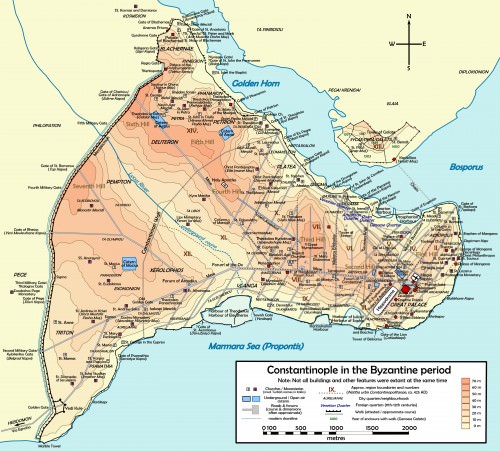
Map of Byzantine Constantinople
CONSTANTINOPLE & RELGION
Given that Constantius was the longest living and most documented of the sons of Constantine it is in his reign that we can best see how the reforms introduced earlier by Constantine the Great developed and worked. This is especially true for the reign of Constantius as he did not change much himself but instead chose to continue with the administrative systems set in place by his father. For example, he ensured the distinction between military and civil posts.
During his reign Constantinople increased in importance becoming more clearly recognisable as an equal to the Eternal City ;Rome. Under Constantius the city increasingly became the centre of the Empire. He was the patron of many important building projects in the city; granaries, Horrea Constantia, bath houses and a library. In addition, the Church of the Holy Apostles was remodelled and improvements were made to the water supply.
Indeed after his work in the city the orator Themistius (Oration 3) stated that Constantinople was now no longer a second city but a true rival to Rome itself.
Constantius also furthered the religious policies of the Constantinian Dynasty. With the Edict of 365 CE he ordered the closure of all pagan temples, forbade access to them and prohibited the performance of sacrifice both private and public; stating that those who disobeyed were to be executed [Cod. Theod. 16.10.4]. Laws such as this and others were specifically designed to break the power and institution of temples in pagan religious practice. Temples were central to almost every activity in paganism, acting as sites of celebration of the cults. Therefore, Constantius' policies were evidently a direct attack on paganism. The Emperor also had the famous statue of Victory removed from the Senate house in Rome as he believed no Christian should have to work in the shadow of a pagan monument. However, other practices were allowed to remain such as the burning of incense and candles which would, interestingly, later be adopted by Christianity.
Constantius died of an illness in 361 CE while marching to do battle with his Caesar, Julian, who had rebelled and claimed the title of Augustus.
Aristotle's On the Heavens › Origins
Ancient Civilizations
One of Aristotle ’s more famous quotes was, "All men naturally desire knowledge" ("πάντες ἄνθρωποι τοὺ εἰδέναι ὀρὲγονται φύσει") (Aristotle, Metaphysics, 1.980a.22). As a classical Greek philosopher, an ideology like this is required for producing many outstanding achievements. He was known as a philosopher, artist, and scientist. Greek-born, he started with humble beginnings by attending Plato ’s academy; becoming one of the most widely known philosophers in human history. Aristotle wrote many books, one of them was On the Heavens ( ΠΕΡΙ ΟΥΡΑΝΟΥ). We are still not sure when the book was officially written, but it was around 350 BCE. His ideas included the four common elements on Earth (earth, air, fire, water), and also a fifth element which we will discuss later. The book revolves around his observations regarding the universe. The theories of Aristotle were groundbreaking for his time and were used until roughly the 1500s CE until the writings of Copernicus.
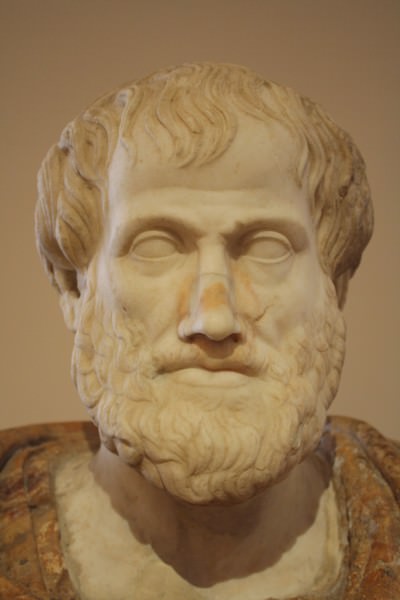
Aristotle
NATURE OF THE UNIVERSE
The first main component to Aristotle's discussion is the nature of the universe. Aristotle concluded that three things make up a physically constituted entity: bodies and magnitudes, beings possessed of body and magnitude, and the principles of causes of these beings. Magnitude divided in one direction is a line, in two directions is a surface, and in three directions, a body. His view was much like our understanding today. We know a line (length) is one dimensional, a shape is two-dimensional (length & width), and most objects in our everyday life, including us, are three-dimensional (length, width, depth). This concept is over 2,000 years old.
He described the four elements of the world and nature - earth (heaviest), water, air, and fire (lightest) - and believed a fifth element existed (aether). To determine whether the body is light or heavy, Aristotle believed 'lightness' was the nature of moving away from the centre and 'heaviness' was the nature of moving toward the centre. The same goes for vertices; the lightest rises to the top, and heaviest moves downward. Aristotle was not the first person to propose the four elements. In the 5th century BCE, Anaximenes recorded the first proposal regarding the four elements making up everything. The elements, when combined, created qualities. Fire and Earth would make Dry; Water and Water would create Cold; Water combined with Air would result in Wet; and finally, Air and Fire would be Hot.
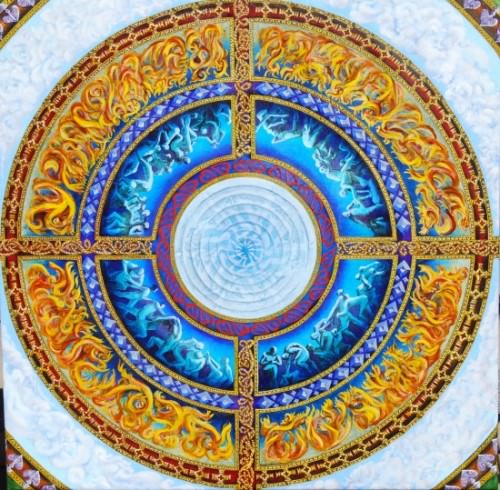
The Four Elements
MOTION
Aristotle took it one step further with his observations of motion. Aristotle postulated that all bodies have a natural way of moving, which could be regular or irregular. He believed that everything that moved was moved by something. The latter is only possible when the irregularity of the movement proceeds from either the mover or from the object moved or both.Basically, this is saying bodies could naturally move in a straight line or not all. This idea is actually a rudimentary form of Newton's first law of motion (an object will remain at rest or in uniform motion in a straight line unless acted upon). He also introduced a third option which was circular motion.
Aristotle noted that the motion of the body moving upward would be fire or air, and downward would be water or earth. This would mean the objects that could be effected by circular motion must be of an exalted substance. Circular motion is connected with more 'heavenly bodies' such as planets. The planets that were allowed to be in circular motion were spheres.These planets revolve around an Earth. He believed the initial motion of the objects was from a 'prime body' who acted on the outermost sphere. Since these spheres are moving in a circular motion, they could neither have weight or lightness as they cannot move naturally or unnaturally towards or away from the centre. The prime body was seen as always running and eternal, going past any other element. This element was known as aether or quintessence. Essentially, this was the fifth element which made up the Sun, planets and stars. Aether or αἰθήρ was described as a pure, perfect substance, which is unlike anything else on Earth.
GEOCENTRIC MODEL
The model created by Aristotle was a part of multiple examples described as the geocentric model. His model had a total of 55 objects in his idea of the universe. At the centre of the universe laid Earth. From the centre to the farthest exterior, the objects were as follows: Earth, Moon, Mercury, Venus, Sun, Mars, Jupiter, and Saturn. Past Saturn, stars were in a fixed position. The interesting part is if we change the position of the Earth and the Sun, then bring the moon to Earth, it would be pretty similar to our current model. This model and many like it lasted until the 16th century CE. Aristotle's universe gradually ended near the stars. The stars were the line between the universe seen by man. Past the stars laid spiritual space where mankind could never go.
ARISTOTLE CREATED A THEORY ON HOW THE EARTH WAS CREATED & HOW THE UNIVERSE IS LAID OUT. HE BELIEVED THE EARTH HAD ALWAYS EXISTED & WAS IN AN ALMOST ETERNAL STATE.
Aristotle also created a theory on how the Earth was created and how the universe is laid out. He believed the Earth had always existed and was in an almost eternal state. The Earth, to his understanding, was unchanged and always provided a perfect circular motion for the revolving bodies. Aristotle argued for a spherical Earth. Around this time, the idea of a flat earth was coming into question. The proof provided by Aristotle was a moon's eclipse. When the moon eclipses, the boundary is always convex. So if the eclipses are due to the interposition of the earth, the shape must be caused by its circumference.Also, he mentioned that the stars provide evidence of Earth also being of no great size. His explanation was if an individual stood in Egypt, while another stood in Cyprus, they would see different sets of stars due to how small the Earth is. A vast change over a small amount of space. Since the Earth was in the centre and always existed, the next question Aristotle had was whether or not the Earth was unique.
IS EARTH UNIQUE?
Since the Earth is in the centre of the universe, and we live at the centre, does this mean the world is unique? Aristotle believed the Earth was unique and that mankind was alone in the universe. His hypothesis behind this was that if there were more than one world and the universe had more than one object at the centre, then elements like earth would have more than one natural place to fall to. The idea is that if multiple centres existed, the planets would be unable to revolve around Earth and have trouble understanding how to move. Remember, his idea of Earth, was that it was also the centre of motion. So by these standards, it makes sense for him to believe the Earth was unique.
The concepts put forth by Aristotle were incredible given the time. In roughly 350 BCE, he was able to identify rudimentary laws of motion prior to Newton's famous three laws. The ability to create a hypothesis of objects being heavier or lighter depending on the distance to the centre is also no small feat. His universe model consisted of 55 objects that aided in his observations and predictions regarding the motion of the planetary objects. The insight put forth by Aristotle was scientific theory at a rudimentary level, based on our model today, and his research shows the use of a scientific process. Though Aristotle's views were not all correct by today's current research, he did lay the fundamental framework for those like Galileo, Copernicus, and Newton. On the Heavens is just one of his many books that attempt to understand life, the universe, and everything. The examples used in this discussion are just the tip of the iceberg, and if anyone wants to read more on similar topics, please consider Physics and Meteorologica.
LICENSE
Article based on information obtained from these sources:with permission from the Website Ancient History Encyclopedia
Content is available under License Creative Commons: Attribution-NonCommercial-ShareAlike 3.0 Unported. CC-BY-NC-SA License